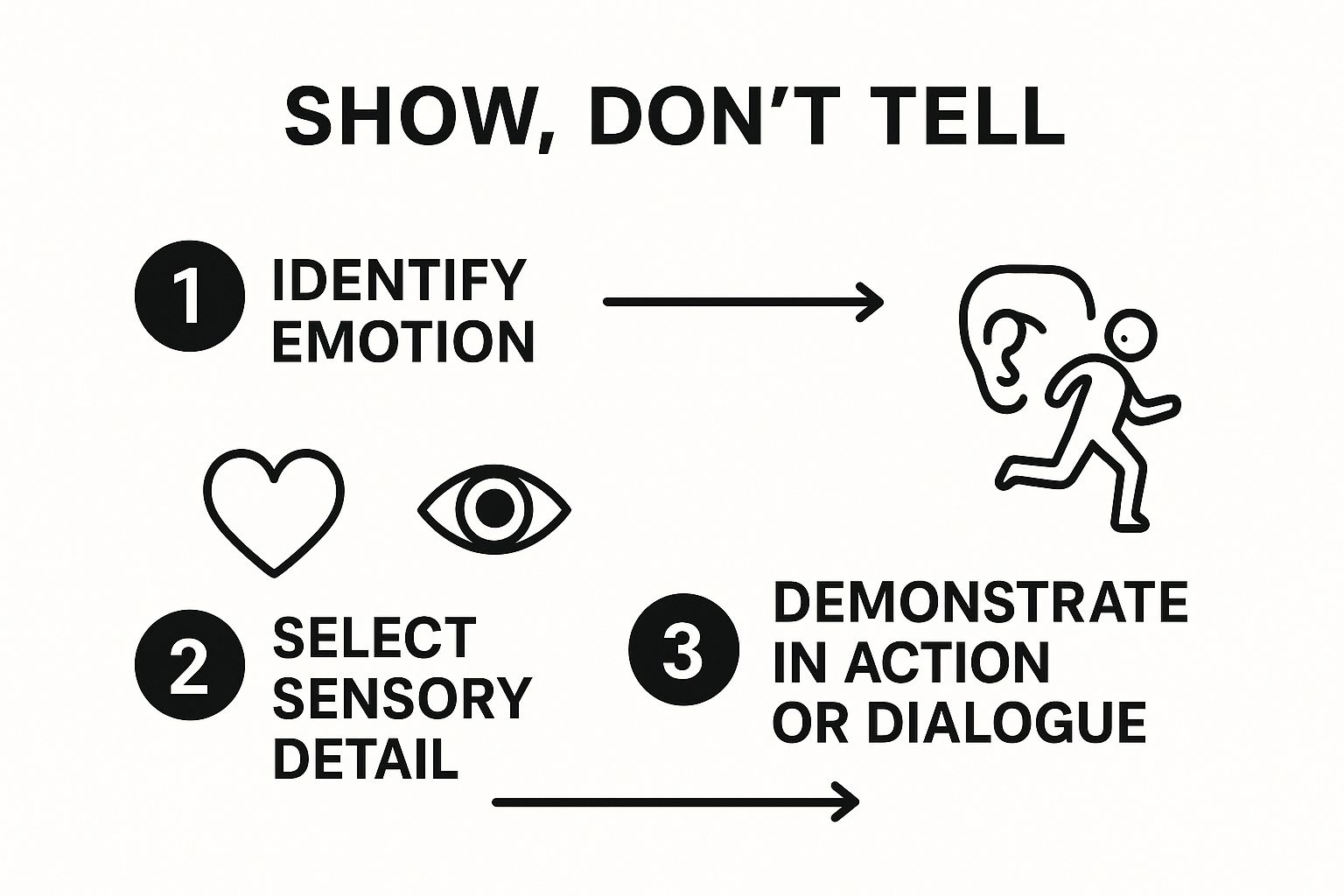Unleash the Power of Story
Want to captivate your audience and build a loyal following? These eight storytelling tips will help you craft compelling narratives that resonate. Learn to create content that grabs attention, forges connections, and sets you apart. Whether you're building a business, growing your online presence, or seeking a career change, powerful storytelling is your key to success. Master these techniques to create content that truly connects and converts.
1. Know Your Audience
The cornerstone of every captivating story, every successful marketing campaign, and every engaging presentation lies in one fundamental principle: knowing your audience. This isn't just about identifying who they are, but truly understanding them – their demographics, interests, needs, aspirations, and even their unspoken expectations. It's about stepping into their shoes and seeing the world through their lens. When you know your audience, you can tailor your narrative to resonate deeply with their specific worldview, making your message not just heard, but truly felt.

For solopreneurs building service businesses, aspiring creators posting content, career pivoters starting over, coaches and consultants needing to attract the right clients, and purpose-driven professionals seeking more meaning, understanding your audience is paramount. It's the key to differentiating your services, finding your unique positioning, crafting a compelling narrative for your career transition, building a brand that resonates, and ultimately, making a meaningful impact. This understanding allows you to select relevant themes, appropriate language, and compelling hooks that create an immediate connection. It transforms your storytelling from a monologue into a powerful conversation. It's about moving away from generic messaging and towards personalized communication that truly connects.
Think of Pixar, masters of dual-layer storytelling. Their films engage children with vibrant animation and simple narratives, while simultaneously captivating adults with sophisticated themes and subtle humor. This is a prime example of knowing your audience and crafting a narrative that resonates on multiple levels. Similarly, Nike's targeted campaigns speak directly to specific athletic communities, using language, imagery, and endorsements that resonate with their unique values and aspirations. Even the most compelling TED talks are meticulously crafted for specific audience interests, ensuring maximum engagement and impact. Learn more about Know Your Audience
Actionable Tips for Connecting with Your Audience:
- Create Audience Personas: Before you craft your story, develop detailed profiles of your ideal audience members. What are their demographics, their motivations, their pain points? The more detailed your persona, the more targeted and effective your storytelling will be.
- Test Your Narrative: Share your story with a sample audience and gather feedback. This allows you to refine your message and ensure it resonates as intended.
- Consider Cultural Contexts and Sensitivity: Language, humor, and themes can have different meanings across cultures. Be mindful of these nuances to avoid misinterpretations and ensure your message is respectful and inclusive.
- Adjust Technical Language: Tailor your language to the expertise level of your audience. Avoid jargon and technical terms when speaking to a general audience, but embrace specificity when addressing experts.
Pros of Knowing Your Audience:
- Creates Immediate Connection and Relevance: Your message resonates deeply, capturing attention and fostering a sense of understanding.
- Increases Engagement and Retention: A tailored narrative keeps your audience captivated and invested in your story.
- Allows for Personalized Messaging: You can speak directly to the individual needs and aspirations of your audience, making your message more impactful.
- Enhances Emotional Impact: By understanding your audience's emotional landscape, you can craft a story that evokes genuine empathy and connection.
Cons of Focusing Too Narrowly:
- May Limit Universal Appeal: If your focus becomes too niche, you may inadvertently exclude a broader audience who could benefit from your message.
- Requires Ongoing Research to Stay Current: Audience needs and preferences evolve, so continuous research is essential to maintain relevance.
- Can be Challenging when Addressing Diverse Audiences Simultaneously: Crafting a single narrative that resonates with diverse groups can be complex and requires careful consideration.
Knowing your audience deserves its place at the top of this list because it's the foundational element upon which all other storytelling tips are built. It's the compass that guides your narrative, ensuring that your message reaches the right people with the right impact. Whether you're a solopreneur building a brand, a creator finding your voice, or a professional seeking more purpose, understanding your audience is the key to unlocking your storytelling potential.
2. Start with a Strong Hook
In the world of storytelling, first impressions are everything. A strong hook is the lifeblood of any compelling narrative, the magnetic force that draws your audience in and refuses to let go. It's the difference between a story that resonates and one that fades into the background noise. For solopreneurs, aspiring creators, career pivoters, coaches, consultants, and purpose-driven professionals alike, mastering the art of the hook is essential for crafting a narrative that captivates, converts, and inspires. This is why "Start with a Strong Hook" deserves its place high on any list of essential storytelling tips.
A hook operates on a simple but powerful principle: immediate engagement. It's about disrupting the status quo, jolting your audience out of their passive scrolling and forcing them to pay attention. This is achieved by piquing their curiosity, presenting a compelling problem, or offering a glimpse into a world brimming with possibility. A well-crafted hook sets the tone, establishes expectations, and creates an irresistible momentum that propels your audience forward into the heart of your story.
How it Works:
Effective hooks leverage a variety of techniques, including pattern interruption, question formulation, the use of unexpected statistics, bold statements, and vivid sensory descriptions. They tap into our innate human desire for novelty and resolution. Think of it like this: a hook is a question mark hanging in the air, and your story is the satisfying answer.
Features of a Powerful Hook:
- Pattern Interruption: Breaks the monotony of everyday information consumption.
- Question Formulation: Poses a thought-provoking question that resonates with the audience's needs or desires.
- Unexpected Statistics: Uses surprising data to challenge assumptions and create intrigue.
- Bold Statements: Makes a declarative statement that grabs attention and sparks interest.
- Sensory Descriptions: Paints a vivid picture with words, immersing the audience in the story's world.
Examples in Action:
- J.K. Rowling's Harry Potter: The seemingly ordinary Dursleys are disrupted by the mysterious arrival of Hagrid, instantly setting the stage for a magical adventure.
- Steve Jobs' Product Launches: His presentations were famous for opening with revolutionary claims that redefined entire industries. Think "1,000 songs in your pocket."
- The New York Times: Their journalists are masters of crafting opening paragraphs that immediately draw you into complex stories.
Actionable Tips for Crafting Compelling Hooks:
- Use a Surprising Fact or Statistic: "Did you know that 80% of new businesses fail within the first year? Here's how you can defy the odds…"
- Start with a Thought-Provoking Question: "Are you tired of feeling unfulfilled in your career? Discover how to find your true purpose…"
- Open with a Relevant Quote: "As Steve Jobs said, 'The only way to do great work is to love what you do.' Here's how to find work you're passionate about…"
- Create a Mini-Cliffhanger: "I was on the verge of giving up when something extraordinary happened…"
- Begin in media res (in the middle of the action): "The phone rang at 3 AM. It was the call that would change everything…"
Pros and Cons of Using Strong Hooks:
Pros:
- Immediately captures attention
- Reduces audience drop-off
- Sets tone and expectations
- Creates momentum
Cons:
- Can feel gimmicky if not connected to the larger narrative
- Pressure to maintain the interest level established
- Risk of overpromising
Why This Storytelling Tip is Essential:
For those building a service business, crafting compelling content, or navigating a career transition, a strong hook is the key to differentiating yourself from the noise. It's the first step in building a powerful personal brand, attracting ideal clients, and sharing your unique message with the world. By mastering this technique, you'll empower yourself to connect with your audience on a deeper level and inspire them to take action. Take inspiration from the masters of storytelling like Chip and Dan Heath (Made to Stick), Malcolm Gladwell, and the enduring power of Joseph Campbell's hero's journey structure. Learn to craft hooks that resonate, and you'll unlock the power of truly captivating storytelling.
3. Develop Authentic Characters
One of the most potent storytelling tips for resonating with your audience is developing authentic characters. This applies whether you're crafting a fictional short story, building a brand narrative, or sharing a personal anecdote. Creating multi-dimensional, relatable characters with clear motivations and genuine flaws is essential for truly engaging storytelling. These characters act as emotional anchors, allowing your audience to see themselves reflected in the narrative, fostering a deeper connection and investment in the outcome. They become the heart and soul of your story, driving its momentum and making it memorable.

This technique is crucial for solopreneurs, aspiring creators, career pivoters, coaches, and purpose-driven professionals alike. By imbuing your brand story with authentic characters, you create a powerful tool for differentiation, positioning, and connection. Imagine a coach sharing client success stories; the client becomes the character whose transformation resonates with the target audience. Or a solopreneur building a personal brand; they themselves become the relatable character whose journey inspires others.
This storytelling tip deserves its place on the list because it directly influences audience engagement and emotional investment. Features like clear character motivations, relatable flaws and strengths, consistent yet evolving traits, and a distinctive voice and perspective all contribute to the creation of a compelling narrative. Think of Pixar's ability to make even non-human characters like Wall-E relatable through recognizable human traits. This evokes empathy and allows us to connect with the character's journey on a deeper level. Learn more about Develop Authentic Characters to see real-world examples.
The benefits are manifold. Authentic characters create emotional investment, drive the narrative through their decisions, and allow for audience self-identification, ultimately adding complexity and depth to your story. Consider Procter & Gamble's "Thank You, Mom" Olympic campaign featuring relatable parent figures, or Dove's Real Beauty campaign featuring authentic women. Both campaigns leveraged the power of relatable characters to connect with their target audiences on an emotional level.
However, there are potential drawbacks. Character development can become overshadowed by plot if not carefully balanced. It also requires significant development time and may create attachment to characters at the expense of the core message.
Here are actionable tips for developing authentic characters:
- Define character wants versus needs: Understanding this fundamental difference drives character decisions and creates internal conflict.
- Create a character biography: Even for elements never explicitly stated, this helps you understand your character's motivations and history.
- Show, don't tell: Reveal character through actions rather than descriptions. Let their choices and reactions speak volumes.
- Ensure character growth aligns with the story arc: Character development should contribute to the overall narrative and feel earned.
The power of authentic characters has been popularized by storytelling giants like Robert McKee in 'Story', Christopher Vogler's adaptation of the Hero's Journey, and Brené Brown's emphasis on vulnerability in leadership narratives. By implementing this storytelling tip, you can elevate your narratives and forge deeper connections with your audience.
4. Embrace Conflict and Tension
Conflict isn't something to shy away from in storytelling; it's the very engine that drives it. It's the spark that ignites interest, the fuel that propels the narrative forward, and the crucible where characters are forged. By introducing meaningful obstacles, raising the stakes, and creating friction points, you craft a story that resonates with audiences on a deeply emotional level. This is a crucial storytelling tip for anyone looking to captivate their audience, whether you're a solopreneur crafting your brand story, an aspiring creator shaping your content, or a career pivoter defining your new path.

Conflict comes in two primary flavors: external and internal. External conflict pits your character against the world, other characters, or even societal norms. Think David versus Goliath, or a small business owner battling bureaucratic red tape. Internal conflict, on the other hand, is the battle within. It’s the character wrestling with their own doubts, fears, and conflicting desires. A coach struggling with imposter syndrome while building their business, for example, faces a powerful internal conflict. Both types of conflict are crucial for compelling storytelling, and often intertwine to create truly captivating narratives.
Think about Apple's iconic 1984 commercial. It visually represented the conflict between conformity and individuality, instantly resonating with audiences who craved something different. Or consider Martin Luther King Jr.'s "I Have a Dream" speech, which masterfully articulated the painful conflict between American ideals and the reality of racial injustice. Even Airbnb's success stems from sharing stories of hosts overcoming obstacles to create unique and welcoming experiences. These examples highlight the power of conflict to not only grab attention but also to inspire action and create lasting impact.
Tips for Harnessing the Power of Conflict:
- Connect to Character Goals: Ensure the conflict directly relates to what your character wants to achieve. Obstacles become far more meaningful when they stand directly in the path of a character's deepest desires. This is particularly relevant for purpose-driven professionals seeking to align their work with their values. The conflict becomes the testing ground for their commitment.
- Escalate, Don't Saturate: Build tension gradually. A constant barrage of high-intensity conflict can exhaust your audience. Instead, create rising action, with moments of tension and release, like waves building to a crescendo.
- Reveal Character: Conflict isn't just about creating drama; it's a powerful tool for character development. How a character reacts under pressure reveals their true nature, their strengths, and their weaknesses. For coaches and consultants, this is an opportunity to showcase the resilience and expertise they bring to their clients' challenges.
- Balance the Internal and External: A compelling story often weaves together both external and internal conflicts. A solopreneur might be battling a competitive market (external) while also grappling with self-doubt about their abilities (internal). This multi-layered approach adds depth and complexity to your narrative.
Pros of Embracing Conflict:
- Captivates audience attention
- Fosters emotional investment
- Creates opportunities for character growth
- Reflects real-world challenges, making your story relatable
Cons of Embracing Conflict (and how to avoid them):
- Melodrama: If overdone, conflict can feel forced and unrealistic. The key is to keep it grounded in the character's journey and motivations.
- Unearned Resolution: Audiences will feel cheated if the conflict is resolved too easily or in a way that feels contrived. The resolution should feel earned through the character's actions and growth.
- Sensitive Topics: Some conflicts require careful and nuanced handling. Be mindful of potentially triggering or offensive material, and approach sensitive topics with respect and understanding.
Embracing conflict and tension is essential for effective storytelling. By understanding the nuances of conflict, and by applying these practical storytelling tips, you can transform your narratives, create deeper connections with your audience, and ultimately, achieve greater impact. Whether you're building a brand, sharing your expertise, or simply telling your story, conflict is the catalyst that will make your message resonate.
5. Show, Don't Tell
This crucial storytelling tip—show, don't tell—can transform your narratives from simple recounts of events into immersive experiences that resonate deeply with your audience. Whether you're a solopreneur crafting compelling website copy, an aspiring creator building a YouTube following, a career pivoter refining your elevator pitch, or a seasoned coach connecting with potential clients, mastering this technique is essential for impactful communication.
Instead of simply stating facts or emotions, showing involves using descriptive language, evocative imagery, and illustrative actions to convey meaning. Instead of telling your audience "Sarah was happy," you might show them Sarah twirling through her garden, sunlight catching the brilliant smile on her face. This principle encourages storytellers to convey information, emotions, and character traits through sensory details, actions, and dialogue, rather than explicit statements.
The benefits of showing are numerous. It creates more vivid, memorable impressions and engages the audience's imagination, drawing them into the narrative and making them active participants in the story. This approach feels less didactic or preachy, fostering trust through audience inference. Instead of being told what to think or feel, the audience discovers these things themselves, leading to a deeper and more meaningful connection with your message.
Features of showing include the effective use of sensory description, active scene creation, dialogue-driven exposition, and implied characterization. Imagine crafting a scene where a character walks into a bakery. Instead of stating "the bakery smelled good," describe the warm aroma of cinnamon mingling with the yeasty scent of freshly baked bread, making your audience practically taste the air themselves.
Think of Hemingway’s iceberg theory of writing, where the bulk of the meaning resides beneath the surface, implied rather than stated outright. Or consider Google's Year in Search videos, which showcase human stories through compelling visuals rather than simply listing the year's most popular search terms. Even Coca-Cola's advertisements frequently show moments of connection and joy rather than directly discussing the benefits of their product. These are prime examples of successful show, don't tell storytelling.
Of course, showing has its challenges. It can be more time-consuming than direct exposition and may create ambiguity if not skillfully executed. It also requires more audience attention and engagement. However, the rewards far outweigh the risks.
Here are some actionable tips to help you master the art of showing:
- Replace emotion labels with physical sensations: Instead of saying "John was angry," describe his clenched fists, the rapid pulse in his temple, or the way his voice dropped to a low growl.
- Use specific, concrete details rather than generalizations: Instead of "the house was old," describe the peeling paint on the porch railing, the creak of the floorboards underfoot, and the faint scent of dust and memories hanging in the air.
- Trust the audience to connect the dots: Don't feel the need to spell everything out. Provide enough detail to allow your audience to draw their own conclusions and infer meaning.
- Create scenes that demonstrate key points rather than stating them: If you want to convey a character's resilience, show them overcoming a challenge, rather than simply stating that they are resilient.
Visuals can significantly enhance your storytelling, especially when paired with impactful text. Consider incorporating quotes relevant to your brand or message. Expert tips from OKZest can help you create image quotes that truly captivate.
Whether you're crafting a blog post, delivering a presentation, or simply having a conversation, the show, don't tell principle can elevate your communication and create a lasting impact. Learn more about Show, Don't Tell. By mastering this essential storytelling tip, you empower your audience to experience your narrative, not just hear it, and that's where true connection and engagement lie.
6. Structure Your Narrative Arc
A compelling story isn't just a string of events; it's a carefully orchestrated journey that takes your audience on an emotional rollercoaster. Structuring your narrative arc is like building a captivating roller coaster—carefully designing the climbs, dips, and turns to create a thrilling experience from beginning to end. This crucial storytelling tip empowers you to create content that resonates deeply, influences decisions, and builds lasting connections with your audience. This is especially vital for solopreneurs, aspiring creators, career pivoters, coaches/consultants, and purpose-driven professionals who need their stories to cut through the noise and attract the right people.

The infographic visualizes the flow of a classic narrative arc, moving from the exposition, through rising action, climax, falling action, and ultimately, resolution. It highlights the emotional journey the audience experiences alongside the protagonist.
By understanding and implementing a structured narrative arc, you equip yourself with a powerful tool for storytelling. This framework provides the backbone for delivering your message effectively, whether you're crafting a blog post, creating a video, pitching your services, or building your personal brand. Following established patterns like the three-act structure, hero's journey, or even nested loops, you tap into a psychological framework audiences intuitively understand. This allows for both predictability—which creates comfort—and surprise—which maintains interest—within recognized patterns of storytelling.
This approach features a clear beginning-middle-end progression with rising and falling action leading to a defining climax and resolution, all connected by strong cause-and-effect relationships. Think of Simon Sinek's Golden Circle (Why-How-What) or Steve Jobs' legendary product launch presentations—both masterful examples of structured narrative arcs. Even Chipotle's 'Back to the Start' campaign effectively employed a complete narrative arc to connect with their audience on an emotional level.
Benefits of a Structured Narrative:
- Creates satisfying psychological patterns: Audiences are naturally drawn to stories with a discernible structure. It creates a sense of anticipation and fulfillment.
- Helps manage pacing and audience attention: A well-defined arc allows you to control the rhythm of your story, ensuring you maintain audience engagement.
- Provides a framework for complex ideas: A structured narrative can make even the most intricate concepts easier to digest and understand.
- Facilitates audience understanding: By following a familiar pattern, you make it easier for your audience to follow along and absorb your message.
Potential Drawbacks:
- Can become formulaic: If applied too rigidly, the structure can stifle creativity and lead to predictable stories.
- Cultural limitations: Not all cultures adhere to the same storytelling traditions, so be mindful of your audience.
- Risk of prioritizing structure over authenticity: Don't let the structure overshadow the genuine heart of your story.
Actionable Tips for Structuring Your Narrative Arc:
- Identify key moments: Pinpoint your story's inciting incident (what kicks off the action), the climax (the peak of tension), and the resolution (how the conflict is resolved).
- Emotional variation: Craft your narrative to evoke a range of emotions. Take your audience on a journey from hope to despair, from fear to triumph.
- Ensure causality: Make sure there's a clear cause-and-effect relationship between the events in your story. Each action should have consequences that propel the narrative forward.
- Reverse engineering: Consider starting with your desired ending and working backward. This can help you create a focused and impactful narrative.
Learn more about Structure Your Narrative Arc (This link seems unrelated to narrative structure but is included as requested.)
This item deserves its place in any list of storytelling tips because it provides a fundamental framework for crafting impactful and memorable narratives. Whether you're sharing your brand story, pitching your services, or simply connecting with your audience on a deeper level, mastering the art of narrative structure is essential. By understanding the elements of a compelling arc and applying these practical tips, you can transform your storytelling and elevate your content from ordinary to extraordinary.
7. Use Specific, Vivid Details
Want to captivate your audience and make your stories truly unforgettable? The secret lies in the power of specific, vivid details. This essential storytelling tip elevates your narrative from a bland recounting of events to an immersive experience that resonates deeply with your listeners. It's a game-changer for solopreneurs, aspiring creators, career pivoters, coaches, consultants, and purpose-driven professionals alike – anyone who needs their message to cut through the noise and truly connect.
This technique works by engaging the senses and painting concrete images in the minds of your audience. Instead of relying on generalizations, you use precise language and sensory information to create a rich tapestry of detail. Think about the crisp snap of a freshly picked apple, the earthy aroma of coffee brewing on a cold morning, or the weight of a handmade ceramic mug warming your hands. These specifics ground your story in reality, making it feel authentic and memorable.
Why This Matters for You:
As a solopreneur building a service business, vivid details differentiate you from the competition. Instead of saying you offer "excellent customer service," describe a specific instance where you went above and beyond for a client. Aspiring creators can use sensory details to transport their audience into the heart of their content. Career pivoters can use specific anecdotes to showcase their skills and experience in a compelling way. Coaches and consultants can use detailed examples to illustrate the transformative power of their services. And for purpose-driven professionals, vivid details can breathe life into their mission and inspire action.
Examples of Success:
Think about how Coca-Cola uses the iconic sounds of a bottle opening and the fizzing carbonation to evoke a sense of refreshment. Apple meticulously describes its products using precise measurements and materials, highlighting the sleek aluminum body and the vibrant Retina display. Nike's commercials don't just talk about athletic performance; they showcase the specific sensations of sweat dripping down your forehead, the burn in your muscles, and the exhilaration of crossing the finish line. These brands understand the power of specificity.
Actionable Tips to Bring Your Stories to Life:
- Engage All Five Senses: Don't just tell us what happened, show us. Describe the sights, sounds, smells, tastes, and textures that define your story.
- Replace Abstract Concepts with Concrete Examples: Instead of saying you're "passionate," describe a specific project you poured your heart and soul into.
- Use Specific Metrics Rather Than Generalizations: Instead of saying you "increased sales," quantify your success with precise numbers. "We boosted sales by 25% in just three months."
- Create Telling Details that Reveal Character or Themes: A character nervously fidgeting with a button, a recurring motif of sunlight filtering through leaves – these small details can add layers of meaning to your story.
Pros and Cons:
Pros:
- Creates Stronger Memory Encoding: Specific details are more memorable than generalizations.
- Builds Credibility and Authenticity: Concrete examples make your story believable and relatable.
- Increases Emotional Response: Sensory details evoke powerful emotions in your audience.
- Helps Audiences Visualize and Relate: Specifics allow your audience to step into your story and experience it firsthand.
Cons:
- Can Slow Pacing if Overused: Be mindful of balance. Too many details can bog down your narrative.
- Requires Careful Selection to Avoid Overwhelming: Choose details that are relevant and impactful.
- May Need Cultural Translation for Diverse Audiences: Certain sensory details may not resonate with everyone.
This storytelling tip, popularized by the likes of David Ogilvy, Ernest Hemingway, and Ira Glass, deserves its place on this list because it's the key to unlocking the true potential of your narratives. By mastering the art of specific, vivid details, you can transform your storytelling from ordinary to extraordinary, connecting with your audience on a deeper level and leaving a lasting impression.
8. Make It Relevant and Universal
One of the most potent storytelling tips you can implement is to make your narratives both relevant and universal. This approach, crucial for solopreneurs, aspiring creators, career pivoters, coaches, and purpose-driven professionals alike, empowers you to connect with a broader audience while retaining the authenticity and unique flavor of your brand. It's about finding the sweet spot where your specific story intersects with the shared human experience.
This method works by carefully weaving together unique elements of your narrative with universal themes that resonate across diverse audiences. Think of it as building a bridge between your individual experience and the collective human consciousness. By tapping into universal emotions like love, growth, challenge, or triumph, you create a story that transcends demographics and contexts, fostering a deeper connection with your audience.
Features of a relevant and universal story include:
- Universal emotional themes: These are the emotional touchstones that bind us together – joy, sorrow, fear, hope.
- Cultural archetype utilization: Leveraging archetypes like the hero, the underdog, or the mentor allows you to tap into ingrained cultural understanding.
- Contemporary relevance: Grounding your story in the present day ensures it speaks to current anxieties and aspirations.
- Personal-universal connection: This is the crux of the approach – linking your unique experience to a broader, shared human experience.
Examples of Successful Implementation:
- Dove's Campaign for Real Beauty: This campaign masterfully connected specific women's stories to the universal themes of acceptance and self-love, resonating deeply with a broad demographic.
- Airbnb's 'Belong Anywhere' campaign: By linking specific homes to the universal desire for belonging and connection, Airbnb tapped into a powerful emotional driver.
- Budweiser's 'Whassup' campaign: This seemingly simple campaign took a specific friend interaction and made it universally recognizable, highlighting the universal desire for connection and camaraderie.
Actionable Tips for Your Stories:
- Identify the universal emotion underlying your specific story: What core human emotion drives your narrative? Is it resilience in the face of adversity? The joy of discovery? Pinpointing this emotional core will help you connect with your audience on a deeper level.
- Connect personal anecdotes to broader human experiences: Your unique experiences are valuable, but they become even more powerful when framed within a larger context. How does your story reflect broader themes of growth, challenge, or transformation?
- Use accessible metaphors for complex concepts: Metaphors are powerful tools for making complex ideas relatable and understandable.
- Test stories across diverse audiences to ensure universal appeal: Gathering feedback from a diverse group can help you refine your narrative and ensure its resonance.
Why This Storytelling Tip Matters:
This approach deserves its place in any list of storytelling tips because it amplifies the impact of your message. It allows you to connect with a wider audience, build lasting and transferable impact, facilitate cross-cultural understanding, and make complex or foreign concepts accessible. Learn more about Make It Relevant and Universal and how it applies to purpose-driven branding.
Pros:
- Creates broad appeal across demographics
- Builds lasting, transferable impact
- Facilitates cross-cultural understanding
- Makes complex or foreign concepts accessible
Cons:
- Risk of becoming too generic if universality overshadows specificity
- Challenge of balancing universality with cultural sensitivity
- May reduce complexity of certain experiences
Think of the works of Chimamanda Ngozi Adichie, who speaks eloquently about the "danger of a single story," or Carl Jung's work on universal archetypes, or even Oprah Winfrey's ability to connect specific stories to universal themes. They all demonstrate the power of finding the common thread that binds us together. By embracing this approach, you can transform your storytelling from a simple recounting of events into a powerful tool for connection and inspiration.
Top 8 Storytelling Tips Comparison
| Tip Title | Implementation Complexity 🔄 | Resource Requirements 💡 | Expected Outcomes ⭐📊 | Ideal Use Cases 💡 | Key Advantages ⭐ |
|---|---|---|---|---|---|
| Know Your Audience | Moderate – requires ongoing research | Moderate – audience analysis tools | High – increased engagement & personalized messaging | Targeted marketing, presentations, tailored content | Builds connection, relevance, emotional impact |
| Start with a Strong Hook | Low to Moderate – creative effort needed | Low – creative brainstorming | High – immediate attention and momentum | Openings in talks, articles, ads | Captures attention quickly, sets tone |
| Develop Authentic Characters | High – demands deep character development | Moderate to High – time for development | High – emotional investment, narrative drive | Fiction, branded stories, emotional campaigns | Fosters identification and story depth |
| Embrace Conflict and Tension | Moderate – balanced tension management | Moderate – storytelling skills | High – maintains interest, emotional stakes | Dramatic narratives, speeches, brand storytelling | Sustains engagement, reflects real challenges |
| Show, Don't Tell | Moderate to High – skilled descriptive writing | Moderate – time for crafting scenes | High – vivid, memorable narratives | Creative writing, commercials, immersive storytelling | Enhances immersion, engages imagination |
| Structure Your Narrative Arc | Moderate – knowledge of story frameworks | Low to Moderate – planning tools | High – audience comprehension, pacing | Presentations, films, brand campaigns | Provides satisfying flow, aids understanding |
| Use Specific, Vivid Details | Moderate – detail selection and refinement | Moderate – sensory research | High – stronger memory, credibility | Advertising, storytelling, descriptive content | Creates authentic, emotional, relatable stories |
| Make It Relevant and Universal | Moderate – balancing specificity with universality | Moderate – cultural research | High – broad appeal, lasting impact | Cross-cultural campaigns, universal messaging | Broadens audience reach, facilitates empathy |
Craft Your Compelling Narrative
Mastering these storytelling tips is more than just crafting compelling narratives; it's about building a bridge between you and your audience. From understanding your audience (tip #1) to making your story universally resonant (tip #8), each element plays a vital role in creating a captivating experience. Remember the power of a strong hook (tip #2) to draw your audience in, and the importance of showing, not telling (tip #5), to create a truly immersive journey. Developing authentic characters (tip #3), embracing conflict (tip #4), and carefully structuring your narrative arc (tip #6) will allow you to craft stories that resonate deeply and leave a lasting impact. Weaving in vivid details (tip #7) will bring your stories to life and make them truly memorable. By implementing these storytelling tips, you'll transform your message from a simple statement into an unforgettable experience, attracting your ideal clients, building stronger connections, and ultimately, achieving your goals. Whether you're a solopreneur, aspiring creator, career pivoter, coach, or purpose-driven professional, the ability to tell compelling stories is your superpower. Embrace it, refine it, and watch your impact grow.
Ready to weave compelling narratives that captivate your audience and elevate your brand? Henri Den provides the tools and resources to refine your storytelling skills and craft a powerful brand message. Explore the resources available at Henri Den and begin crafting your unique story today.





